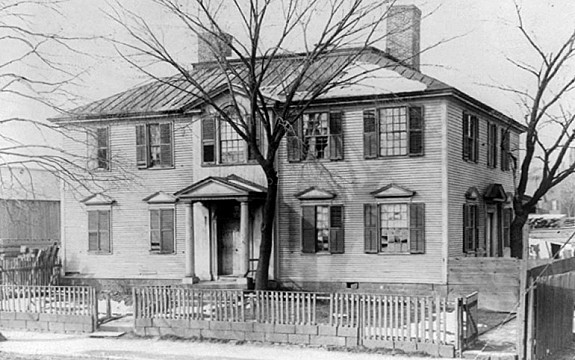Arnold House
Water Street, New Haven, Connecticut
Built in 1771, for America's favorite anti-hero, Brigadier-General Benedict Arnold (1741-1801) and his first wife, Margaret Mansfield (1745-1775). Before embarking on his military career, Arnold was a successful merchant who moved from the Arnold Homestead at Norwich in 1761 and initially set himself up in New Haven as a druggist and bookseller. However, he quickly moved into the import-export business with Adam Babcock, trading with three vessels between New England, Quebec, and the West Indies. When he was away, he left his store on Water Street in the very capable hands of his sister, Hannah. In 1767 he married Margaret, daughter of the High Sheriff of New Haven County and a fellow Freemason who became a partner in his business and helped protect him from his creditors. To accommodate his wife, children, and unmarried sister, he built this home at the corner of Olive Street near his store overlooking the harbor....

This house is best associated with...
Arnold's house stood on three acres and the orchard he laid out here was, "the largest and finest in New Haven, and the grounds were laid out in handsome terraces". He enjoyed the home on-and-off for four short years before he was appointed a Captain in the Connecticut militia. The remainder of his military career is well-documented and an overview can be seen here, but once outed as a traitor his property was confiscated.
His wife had died here in 1775 and after that his sister had raised their three sons here. But, in 1780, Judge Pierpont Edwards sold the Arnold House on behalf of the government to Captain Isaac Prout. Having put a down payment on it, Prout was unable to keep up with the subsequent payments and it was purchased in about 1798 by the "Father of American Scholarship and Education," Noah Webster. Webster lived here with his family until about 1812. It wasn't until 1822 that he built the house with which he is better associated at New Haven and which can still be seen today albeit at Dearborn in Michigan, moved there by the car-manufacturer Henry Ford for his historical outdoor museum.
Noah Webster sold the home to Captain James Hunt, who like Arnold had made his fortune in the West Indian trade. On his death, he bequeathed it to his daughter, Mary, who in 1851 had married Captain D. Goffe Phipps. Mrs Phipps and her sister were the co-owners of the Cutler Block in New Haven (inherited from their grandfather, Richard Cutler) and in 1873 she and her husband left the Arnold House in favor of their new red brick home which still stands today at 614 Chapel Street. Nonetheless, the house remained in Mrs Phipps' ownership despite having been threatened with demolition several times and having fallen into bad a state of disrepair. She leased it for several years to a lumber merchant for storage before it was demolished in or shortly after 1910.
His wife had died here in 1775 and after that his sister had raised their three sons here. But, in 1780, Judge Pierpont Edwards sold the Arnold House on behalf of the government to Captain Isaac Prout. Having put a down payment on it, Prout was unable to keep up with the subsequent payments and it was purchased in about 1798 by the "Father of American Scholarship and Education," Noah Webster. Webster lived here with his family until about 1812. It wasn't until 1822 that he built the house with which he is better associated at New Haven and which can still be seen today albeit at Dearborn in Michigan, moved there by the car-manufacturer Henry Ford for his historical outdoor museum.
Noah Webster sold the home to Captain James Hunt, who like Arnold had made his fortune in the West Indian trade. On his death, he bequeathed it to his daughter, Mary, who in 1851 had married Captain D. Goffe Phipps. Mrs Phipps and her sister were the co-owners of the Cutler Block in New Haven (inherited from their grandfather, Richard Cutler) and in 1873 she and her husband left the Arnold House in favor of their new red brick home which still stands today at 614 Chapel Street. Nonetheless, the house remained in Mrs Phipps' ownership despite having been threatened with demolition several times and having fallen into bad a state of disrepair. She leased it for several years to a lumber merchant for storage before it was demolished in or shortly after 1910.
You May Also Like...
Categories
Styles
Share
Image Courtesy of the Library of Congress; Benedict Arnold's House, 8 May, 1890 - California Digital Newspaper Collection; Benedict Arnold's House, Rocky Mountain Sun, 1890;
Connections
Be the first to connect to this house. Connect to record your link to this house. or just to show you love it! Connect to Arnold House →













